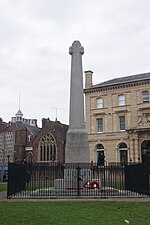Colson's
Defunct department stores of the United KingdomDefunct retail companies of the United KingdomHouse of FraserRetail companies established in 1792Use British English from August 2015

Colson's, later Dingle's and House of Fraser, was a department store located in Exeter, Devon, England. Located on the High Street, the store was founded in 1792, then expanded after damage in the Second World War. It was later purchased and grouped with Plymouth-based Dingles, taking their name, before becoming House of Fraser. The store closed in 2019, along with a number of other House of Fraser stores during financial difficulties at the group. The site was derelict for a number of years, before being renovated during 2022 by IHG Hotels & Resorts as a Hotel Indigo, including a restaurant named "Colson's" in recognition of the history of the building.
Excerpt from the Wikipedia article Colson's (License: CC BY-SA 3.0, Authors, Images).Colson's
High Street, Exeter Newtown
Geographical coordinates (GPS) Address Nearby Places Show on map
Geographical coordinates (GPS)
| Latitude | Longitude |
|---|---|
| N 50.7239 ° | E -3.5302 ° |
Address
High Street 35
EX4 3LN Exeter, Newtown
England, United Kingdom
Open on Google Maps











